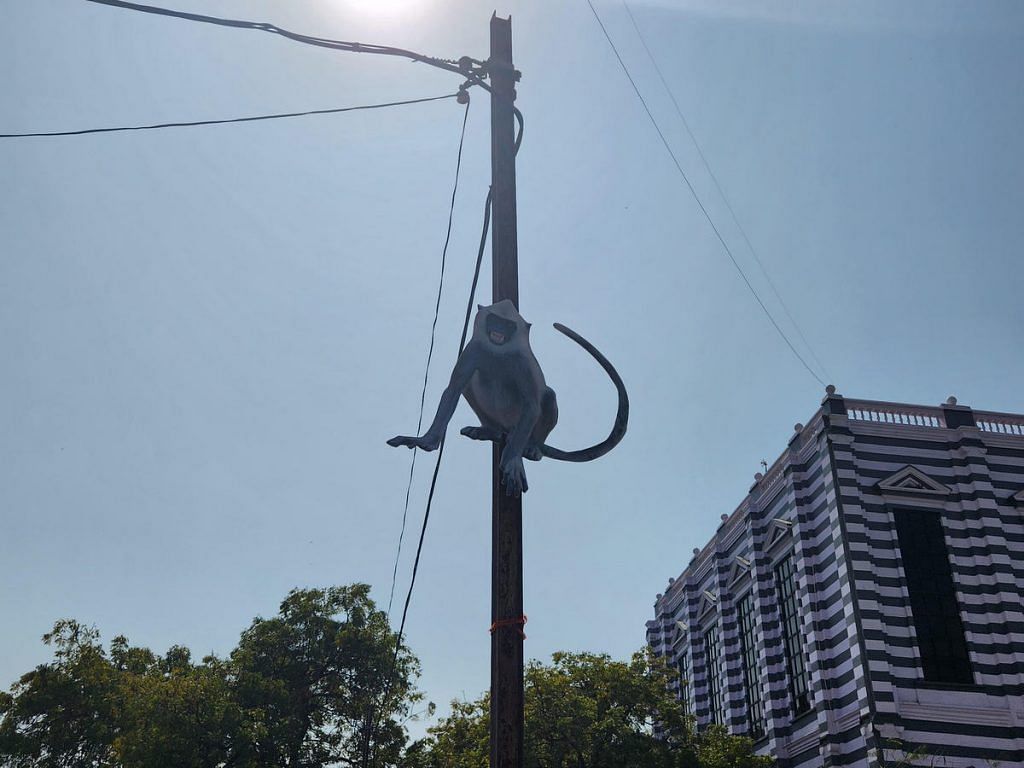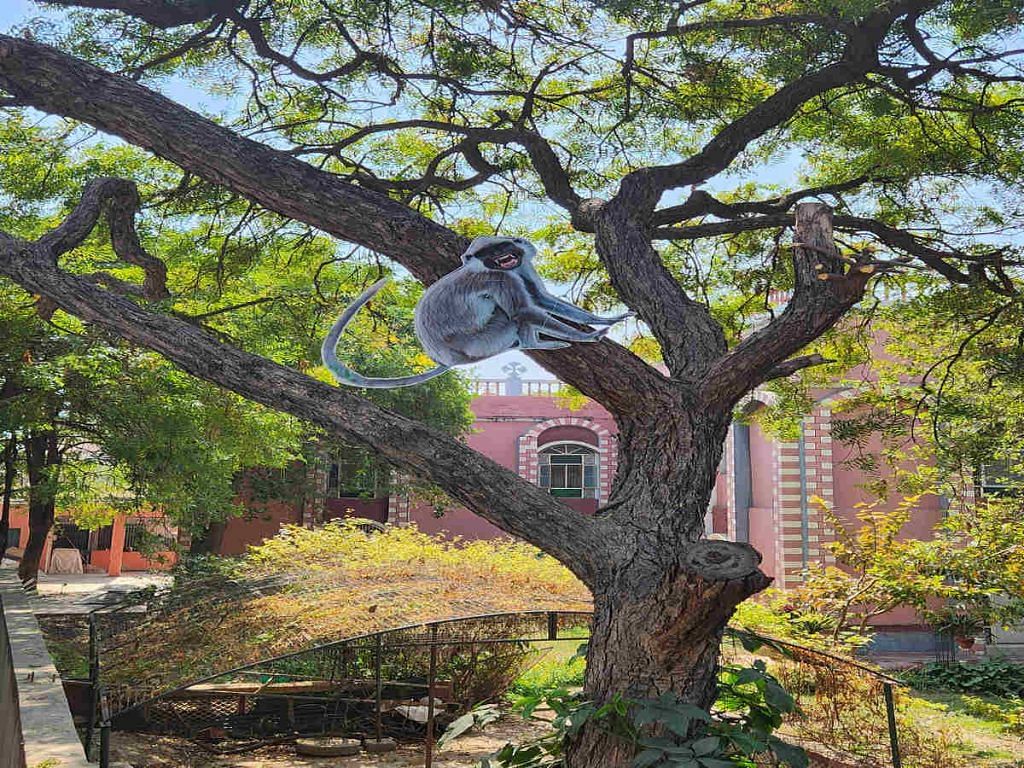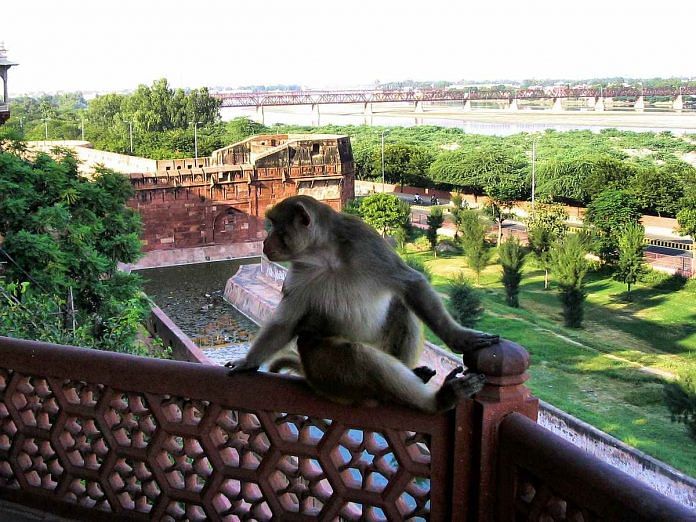Agra: On a bright Saturday morning this month, 23-year-old Mulayam Singh, a car showroom employee in Agra, hopped on to his bike and drove down Yamuna Kinara Road to pick up his wife from her maternal home. He never arrived. Eyewitnesses said a monkey jumped on Mulayam’s back, causing him to fall on the road. Before he could get up, a bus crushed him under its wheels. Mulayam died instantly.
Then there is the heart-wrenching story of baby Arush, only 12 days old. He was reportedly being fed by his mother at their home in Agra’s Runkata area in November 2018, when a monkey entered the house and snatched him from her arms. The infant was later found bleeding on a neighbour’s terrace. He was declared dead at the hospital.
Or take the case of 55-year-old Hari Shankar. He was chatting with neighbours outside his house in Agra’s Old City area in 2019 when a swarm of monkeys attacked him. According to reports, the panicked man tried to run to safety but fell while climbing stairs and succumbed to a head injury.
These are not isolated incidents. Over the past few years, many people have been killed or grievously injured as a result of the monkey menace in Agra. The fatalities have mostly children, elderly people, or those who are physically unable to defend themselves.
Monkeys have attacked foreign tourists too, like a Spanish woman who was bitten on her leg while clicking pictures at the Taj Mahal last September, although no deaths have been reported — yet.
When asked about official data on monkey-related deaths, Agra’s Chief Medical Officer Dr. Arun Kumar Srivastava, said it was difficult to pin down exact numbers.
“We do not categorise deaths in this way. All deaths caused by monkeys are recorded as accidental, so it is very difficult to assign a number to such cases,” he said.
“We do keep a record of all animal bite cases where the anti-rabies vaccine is administered to the victims, but that includes all animals. No separate data is maintained for monkey bites,” he added.
With the summer months approaching, there are fears locally that there may be a spike in injuries and deaths since monkeys are believed to get more aggressive in the heat. There also tends to be more human-animal contact, since people frequent their terraces and monkeys, too, seek shelter under coolers, canopies and the like. There is, however, no official documentation of increased attacks in summer.
Also read: Meat, markets and memory—Asha Thadani’s photos explore India’s relationship with animals
‘Killers’ on the loose?
A public interest litigation (PIL) filed last year in the Allahabad High Court last June sought court intervention in addressing the “menace of monkeys” in Agra. It noted that the city is home to about 30,000 rhesus macaques, whose proliferation amounts to an infringement of Article 21 of the Constitution — the fundamental Right to Life.
This may not be an exaggeration. In addition to the cases described earlier, several people have died in recent years as a direct or indirect result of monkey aggression, sometimes in gruesome and unforeseen ways.
For instance, in October 2020, a territorial war between two large monkey gangs resulted in the collapse of a dilapidated wall in the city’s Ghatia Azam Khan. Laxman Tulisiani, a gold valuer, and Veera, a labourer, were on the second floor of the house when the wall of the third floor fell on them. Both died before they could be pulled out of the debris.

Then there was the rescue that turned deadly. In March 2020, a 10-year-old girl called Sania went to the terrace of her home in Shahganj. There, eight to 10 monkeys spotted her and ran towards her. When the girl’s father, Usman, heard her screams, he rushed up to help, stick in hand. When the monkeys saw Usman, they abandoned Sania and attacked him. Two monkeys leapt onto his chest and Usman fell to his death on the street.
The list goes on — from 59-year-old Bhuran Devi who reportedly bled to death after monkeys bit her in November 2018, to 35-year-old Renu Gupta who fell to her demise while trying to flee from a group of monkeys in Firozabad this January.
The number of close shaves is even higher, including of babies and toddlers being bitten and scratched by simians, and not all incidents are even reported.
Based on the PIL last year, the Allahabad HC issued a notice to the Uttar Pradesh government and Agra authorities about monkeys’ reign of terror in the city. While certain measures have been somewhat helpful, the problem is far from over, as evidenced by macaques tearing down the vertical garden near the Taj Mahal’s VIP gate this month, just ahead of the visit of G20 delegates in the city.
What are the authorities doing?
Dr Ajay Kumar Yadav, district veterinary officer, told ThePrint that the Agra municipal corporation has been working to curb the monkey population.
“Every day, several municipal corporation teams work to catch monkeys throughout the city, including the Taj Mahal. These monkeys are captured and sterilised,” Yadav said, adding that the city’s residents will soon be free of the threat posed by monkeys.
Residents that ThePrint spoke to, however, have their reservations given that the issue has persisted for years.
Some have installed large iron grills around their roofs, while others have invested in solar-powered ‘electric shock machines’. These measures are expensive, but people are afraid for their lives.
A few residents have even moved homes, like Rahul Shrotriya, a former resident of the Kachehri Ghat area. Shrotriya told ThePrint that monkeys were the main reason why his family shifted to the outskirts of the city.
“I used to breed pigeons on the terrace, and monkeys had a habit of destroying the cages in order to steal the eggs. If chased, the monkeys used to get aggressive,” Shrotriya said.
However, a simple and cost-effective method has had some success in keeping monkeys away from certain areas.
Prashasti Srivastava, public relations officer of the Agra Railway Division, said that marauding gangs of monkeys had become a threat to passengers at the Agra Cantonment Railway Station, attacking them and stealing their belongings.
Since culling the monkeys was not an option, the railway authorities put up life-size cutouts of grey langurs, also called Hanuman langurs, throughout the station this January. Macaques are believed to fear the species and it was hoped that the images would scare off the simians. The method seems to have had some success.
Since the cutouts went up, there have been no monkey attacks at the station or surrounding areas, Srivastava said.

Now, St. Peter’s College, a well-known school in the city, has also adopted this method after suffering a long-standing monkey infestation.
The school currently has around 30 cutouts and posters of langurs displayed throughout the premises, including on trees and the boundary walls.
Father Andrew Correia, the school’s principal, told ThePrint that the results have been promising.
“The monkeys used to steal the children’s food and destroy the trees and plants that had been planted at the school,” he said, adding that he decided to try the langur cutout method after seeing it in use at the Agra Cantt station. The monkeys are now staying away from the school grounds, he said.
‘Feeding monkeys should be prohibited’
According to a 2021 study published in Medicine, Science and the Law, the official peer-reviewed journal of the British Academy for Forensic Sciences, macaques are known to be “extremely aggressive”, especially while defending their territory.
While some attacks on humans take place without provocation, other instances may occur when the animals feel “intimidated by behaviour such as prolonged direct eye contact”, the study says.
In Agra, there has been a blurring of boundaries between animal and human habitats, leading to conflict situations. This is exacerbated by people encouraging monkeys by giving them food.
Speaking to ThePrint, environmentalist and leading ENT surgeon Dr. Devashish Bhattacharya underscored this issue.
“In every temple, large gangs of monkeys are fed by devotees on Tuesdays and Saturdays. Such monkeys start living in the area hoping to find more food and if not offered food, they snatch it out of hunger,” he said.
“If monkeys must be removed from the city, the first step would be to prohibit feeding monkeys entirely,” he added.
According to Bhattacharya, measures like sterilisation are not enough given the urgency of the issue, and have so far not proven to be very effective in Agra.
“Monkeys have lifespans that can be as long as 20 years, and sterilised monkeys could live longer in the city due to loss of aggression and an abundance of food. While female monkeys attack to protect their young, adult males fight for territory. If they don’t fight, they will live longer,” he said.
(Edited by Asavari Singh)
Also read: 2 dog-bite deaths in 1 week — after Noida baby, Madhya Pradesh five-yr-old attacked by strays



